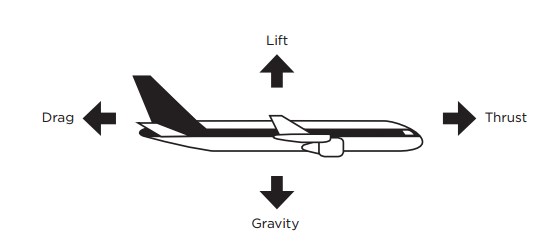

- THIS FORCE IS CREATED BY THE ENGINES OF AN AIRPLANE HOW TO
- THIS FORCE IS CREATED BY THE ENGINES OF AN AIRPLANE SIMULATOR

Thrust is generated under Newton's principle that "every action has an equal and opposite reaction." For example, imagine that you are floating in space and you weigh 100 pounds on Earth. And if a rocket engine produced 5,000 pounds of thrust applied to a 5,000-pound object floating in space, the 5,000-pound object would accelerate at a rate of 32 feet per second per second. Likewise, a jet engine producing 5,000 pounds of thrust could hold 5,000 pounds of material suspended in the air. Therefore, if you have a jet engine capable of producing 1 pound of thrust, it could hold 1 pound of material suspended in the air if the jet were pointed straight down. A "pound of thrust" is equal to a force able to accelerate 1 pound of material 32 feet per second per second (32 feet per second per second happens to be equivalent to the acceleration provided by gravity). Thrust is generally measured in pounds in the United States (the metric system uses Newtons, where 4.45 Newtons equals 1 pound of thrust). RangeGames is an interactive JavaScript application which allows you to study how different types of aircraft use different types of engines to meet their mission.The goal of a turbofan engine is to produce thrust to drive the airplane forward. You can learn the fundamentals of turbine engine propulsion with the EngineSim simulator.
THIS FORCE IS CREATED BY THE ENGINES OF AN AIRPLANE SIMULATOR
Jet Engine Interactive Simulator is an interactive JavaScript application which allows you to study different types of jet engines. The DC-8 is powered by four high-bypass turbofan engines, the F-14 by two afterburning low-bypass turbofans, the C-130 by four turboprop engines, and the T-38 by two turbojet engines.
THIS FORCE IS CREATED BY THE ENGINES OF AN AIRPLANE HOW TO
It is used to teach pilots how to fly jet aircraft and does not have the acceleration requirements of the F-14. Like the DC-8, it carries cargo a long distance, but it does not have the high-speed requirement of the DC-8.Īt the upper right is a T-38 trainer. At the lower right is a C-130 cargo aircraft. It spends most of its life in cruise but needs high acceleration when in combat. Its mission is to shoot down other aircraft in air-to-air combat. It spends most of its life in high-speed cruise.Īt the lower left is an F-14 fighter plane.

Its mission is to carry large loads of passengers or cargo for a long distance at high speed. Each aircraft has a unique mission and therefore a unique propulsion requirement. On the slide we see pictures of four different aircraft equipped with gas turbine engines. All gas turbine engines have some parts in common, however. Turbine engines come in a wide variety of shapes and sizes because of the many different aircraft missions. Because gas turbine engines are so important for modern life, we will be providing a lot of information about turbine engines and their operation. Most modern, high-speed passenger and military aircraft are powered by gas turbine engines. Most of the mass of the jet exhaust comes from the surrounding atmosphere. For a gas turbine engine, the accelerated gas, or working fluid, is the jet exhaust. A turbine engine does not work in outer space because there is no surrounding air. But unlike the rocket engine which must carry its oxygen for combustion, the turbine engine gets its oxygen from the surrounding air. Early gas turbine engines worked much like a rocket engine creating a hot exhaust gas which was passed through a nozzle to produce thrust. We sometimes call this engine a jet engine. This engine was called a gas turbine engine. Gas Turbine/ Jet Engineĭuring World War II, a new type of airplane engine was developed independently in Germany and in England.

A general derivation of the thrust equation shows that the amount of thrust generated depends on the mass flow through the engine and the exit velocity of the gas. In any propulsion system, a working fluid is accelerated by the system and the reaction to this acceleration produces a force on the system. For every action there is an equal and opposite reaction. Different propulsion systems develop thrust in different ways, but all thrust is generated through some application of Newton’s third law of motion. Thrust is generated by the propulsion system of the aircraft. Thrust is the force which moves any aircraft through the air. Home > Beginners Guide to Aeronautics Gas Turbine Propulsion Gas Turbine Propulsion Thrust and Force


 0 kommentar(er)
0 kommentar(er)
